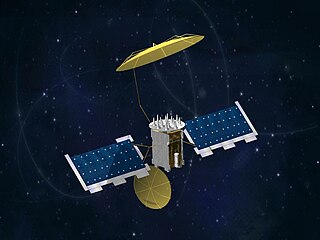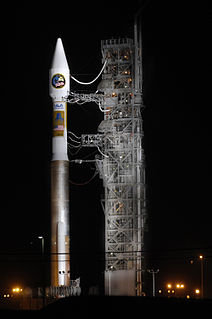
Milstar is a constellation of military communications satellites in geosynchronous orbit, which are operated by the United States Space Force, and provide secure and jam-resistant worldwide communications to meet the requirements of the Armed Forces of the United States. Six spacecraft were launched between 1994 and 2003, of which five are currently operational; the third launch failed, both damaging the satellite and leaving it in an unusable orbit.

Atlas V is an expendable launch system and the fifth major version in the Atlas launch vehicle family. It was originally designed by Lockheed Martin, now being operated by United Launch Alliance (ULA), a joint venture between Lockheed Martin and Boeing. Atlas V is also a major NASA launch vehicle. It is America's longest-serving active rocket. In August 2021, ULA announced that Atlas V would be retired, and all 29 remaining launches had been sold. As of 5 August 2022, 21 launches remain.

The Mobile User Objective System (MUOS) is a United States Space Force narrowband military communications satellite system that supports a worldwide, multi-service population of users in the ultra high frequency (UHF) band. The system provides increased communications capabilities to newer, smaller terminals while still supporting interoperability with legacy terminals. MUOS is designed to support users who require greater mobility, higher bit rates and improved operational availability. The MUOS was declared fully operational for use in 2019.

United Launch Alliance (ULA), legally United Launch Alliance, LLC, is an American spacecraft launch service provider that manufactures and operates a number of rocket vehicles that are capable of launching spacecraft into orbits around Earth and to other bodies in the Solar System. The company, which is a joint venture between Lockheed Martin Space and Boeing Defense, Space & Security, was formed in December 2006. Launch customers of the United Launch Alliance include the Department of Defense (DoD), NASA, and other organizations.

The Wideband Global SATCOM system (WGS) is a high capacity United States Space Force satellite communications system planned for use in partnership by the United States Department of Defense (DoD), Canadian Department of National Defence (DND) and the Australian Department of Defence. The system is composed of the Space Segment satellites, the Terminal Segment users and the Control Segment operators.

Advanced Extremely High Frequency (AEHF) is a constellation of communications satellites operated by the United States Space Force. They are used to relay secure communications for the United States Armed Forces, the British Armed Forces, the Canadian Armed Forces, the Netherlands Armed Forces and the Australian Defence Force. The system consists of six satellites in geostationary orbits. The final satellite was launched on 26 March 2020. AEHF is backward compatible with, and replaces, the older Milstar system and will operate at 44 GHz uplink and 20 GHz downlink. The AEHF system is a joint service communications system that provides survivable, global, secure, protected, and jam-resistant communications for high-priority military ground, sea and air assets.

USA-195, or Wideband Global SATCOM 1 (WGS-1) is a United States military communications satellite operated by the United States Air Force as part of the Wideband Global SATCOM programme. Launched in 2007, it was the first WGS satellite to reach orbit. It is stationed at a longitude of 174.8° East.

USA-200, also known as NRO Launch 28 or NROL-28, is an American signals intelligence satellite, operated by the National Reconnaissance Office. Launched in 2008, it has been identified as the second satellite in a series known as Improved Trumpet, Advanced Trumpet, or Trumpet follow-on; a replacement for the earlier Trumpet series of satellites.

USA-214, also known as Advanced Extremely High Frequency-1 or AEHF-1, is a military communications satellite operated by the United States Air Force. It is the first of six satellites to be launched as part of the Advanced Extremely High Frequency program, which will replace the earlier Milstar system.

USA-233, or Wideband Global SATCOM 4 (WGS-4) is a United States military communications satellite operated by the United States Air Force as part of the Wideband Global SATCOM programme, which was launched in 2012. The fourth Wideband Global SATCOM satellite, it is the first WGS Block II satellite to be launched. It is stationed at 88.5° East in geostationary orbit.

USA-242, also known as GPS IIF-4, GPS IIF SV-5, Navstar-68 and Vega, is an American navigation satellite which was launched on 15 May 2013 and became operational on 21 June 2013. The fourth Block IIF GPS satellite, it forms part of the Global Positioning System.
USA-5, also known as Navstar 10, GPS I-10 and GPS SVN-10, was an American navigation satellite launched in 1984 as part of the Global Positioning System (GPS) development programme. It was the tenth of eleven Block I GPS satellites to be launched.

USA-204, or Wideband Global SATCOM 2 (WGS-2) is a United States military communications satellite which is operated by the United States Air Force as part of the Wideband Global SATCOM programme. Launched in 2009, it was the second WGS satellite to reach orbit, and operates in geostationary orbit at a longitude of 60° East.

USA-256, also known as GPS IIF-7, GPS SVN-68 and NAVSTAR 71, is an American navigation satellite which forms part of the Global Positioning System. It was the seventh of twelve Block IIF satellites to be launched.

USA-258, also known as GPS IIF-8, GPS SVN-69 and NAVSTAR 72, is an American navigation satellite which forms part of the Global Positioning System. It was the eighth of twelve Block IIF satellites to be launched.

USA-265, also known as GPS IIF-11, GPS SVN-73 and NAVSTAR 75, is an American navigation satellite which forms part of the Global Positioning System. It was the eleventh of twelve Block IIF satellites to be launched.

USA-246, also known as Advanced Extremely High Frequency 3 or AEHF-3, is a military communications satellite operated by the United States Air Force. It is the third of six satellites to be launched as part of the Advanced Extremely High Frequency program, which replaced the earlier Milstar system.

USA-288, also known as Advanced Extremely High Frequency 4 or AEHF-4, is a military communications satellite operated by the United States Air Force. It is the fourth of six satellite to be launched as part of the Advanced Extremely High Frequency program, which replaced the earlier Milstar system.

USA-292, also known as Advanced Extremely High Frequency 5 or AEHF-5, is a military communications satellite operated by the United States Air Force. It is the fifth of six satellite to be launched as part of the Advanced Extremely High Frequency program, which replaced the earlier Milstar system.

USA-298, also known as Advanced Extremely High Frequency 6 or AEHF-6, is a military communications satellite operated by the United States Space Force (USSF). It is the sixth of six satellite to be launched as part of the Advanced Extremely High Frequency program, which replaced the earlier Milstar system.









